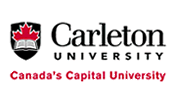 |
|
||||
Org: Jim Pandey (Carleton)
[PDF]
- EMMANUEL DELSINNE, Université d'Ottawa, 585 King Edward, Ottawa, ON, K1N 6N5
The relative Lehmer problem in a torus [PDF] -
The Lehmer problem consists in finding lower bounds for the Weil height of an algebraic number in terms of its degree over Q. Even if there is still no answer to Lehmer's original question, the sharpest corresponding conjecture has been proved up to an epsilon. Besides, there are several generalizations of this problem. On one hand, one can formulate the same kind of conjecture replacing the field of rationals by an abelian extension of a number field. On the other hand, one can generalize these statements in higher dimension. The point is to find lower bounds for the height of a point of a torus; in this case, we substitute to the degree a more precise invariant: the obstruction index. It is then natural to try to combine these two generalizations: this is the relative Lehmer problem in a torus.
- YAN DUOKUI, Brigham Young University
Collinear Four Body Problem [PDF] -
In this paper, we use canonical transformations to collectively analytically continue the singularities of the simultaneous binary collision solutions for the collinear four-body problem in both the decoupled case and the coupled case. All the solutions are found and more importantly, we describe the relationship between the decoupled solutions and the coupled solutions. Also, the existence a special periodic orbit with singularity is proved and also numerical evidence is given.
- ZIZO FARRAG, Dalhousie University
Fault Tolerance of Distributed Loop Networks [PDF] -
In this paper, we examine the problem of extending a multiple loop network so as to tolerate any given number of node failures. Our method is simple to implement, and produces efficient solutions.
- REBECCA HAMMOND, Acadia University, Wolfville, Nova Scotia
A two-delay differential equation model for a mite population with multiple life stages. [PDF] -
Various species of pest mites pose significant challenges for apple growers worldwide. In Nova Scotia's Annapolis Valley, infestations of phytophagous mites, primarily the European red mite, Panonychus ulmi (Koch), can cause serious economic losses in apple orchards. The mites damage the leaves, which results in excessive fruit drop, thus causing lower yields and poorer fruit quality. A mathematical model of the population dynamics of the European red mite can provide insight into ways to control the mites. In this talk, potential delay differential equation models for the European red mite are explored. It is shown that a two-delay model is superior to a single-delay equation model in capturing the population dynamics of the pest.
- BEHZAD OMIDI KOMA, Carleton University
The number of irreducible polynomials of degree q-1 over Fq× with given trace and constant terms [PDF] -
The problem of estimating the number of irreducible polynomials with some prescribed coefficients of degree n over the finite field Fq of q elements has been largely studied. We give a simple and precise formula for the number of irreducible polynomials of degree n=q-1 over Fq with given trace and primitive constant term. Then, we consider the number of irreducible polynomials of degree n=q-1 over Fq with given trace and any arbitrary constant term. For this latter number, we provide better bounds than the existing ones.
- FRANKLIN MENDIVIL, Acadia University, Wolfville, Nova Scotia
A Monge-Kantarovich metric for signed measures [PDF] -
In this talk we discuss an extension of the Monge-Kantarovich metric to signed measures. The main result is a completeness result for a space of signed measures with respect to this metric.
- MARYAM NAMAZI, University of Victora, Victoria, BC
The extra-tropical effects on the equatorially trapped waves [PDF] -
The equatorial atmosphere harbours a large spectrum of waves that are trapped near and travel along the equator. These equatorially trapped waves interact nonlinearly with each other and with the planetary-barotropic waves.
We consider the fully non-linear hydrostatic primitive equations on a beta-plane projected onto the two first modes of vertical structure, leading to two coupled shallow water systems. Here, we discuss the effect of a meridional barotropic shear on the equatorially trapped Kelvin waves by using three different numerical methods. We compare the performance of the f-wave method, the central scheme and a relaxation type scheme that permits to preserve exactly the meridional balance of the Kelvin wave and its zero meridional velocity, for the non-forced case. We demonstrate that, due to the meridional dependence of the numerical phase speed, the central scheme yields strong artificial deformations in the structure and dynamics of waves and thus it is inadequate for equatorially trapped waves. Moreover, the effect of meridional shear on an equatorial Kelvin wave is accurately captured by our relaxation scheme for equatorially trapped waves since the shear actually induces a weak but non-trivial meridional velocity.
- JAMES SHORT, Carleton
How to find a massive prime number [PDF] -
We review the properties of Mersenne Numbers and how they can be used to identity large prime numbers. These examined properties will serve as a basis for the definition of a new class of integers which shall be called General Mersenne Numbers (GM numbers). A simple method on how to generate GM numbers will be presented. We shall examine the relative primality frequency of these numbers in comparison to the Mersenne Numbers. From an examination of the weaknesses of these numbers with regards to the purpose of identifying big primes, we shall define a second class of integers which shall be called Super General Mersenne Numbers (SGM numbers). A brief discussion on some open questions with regards to furthering this work shall be given.





